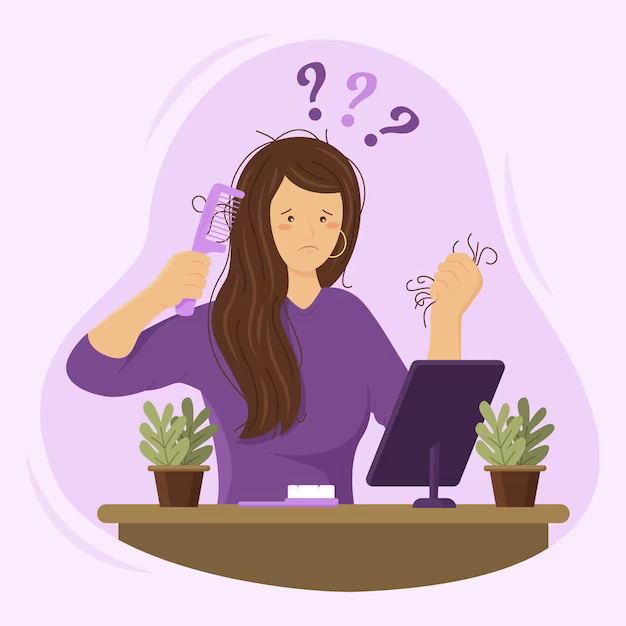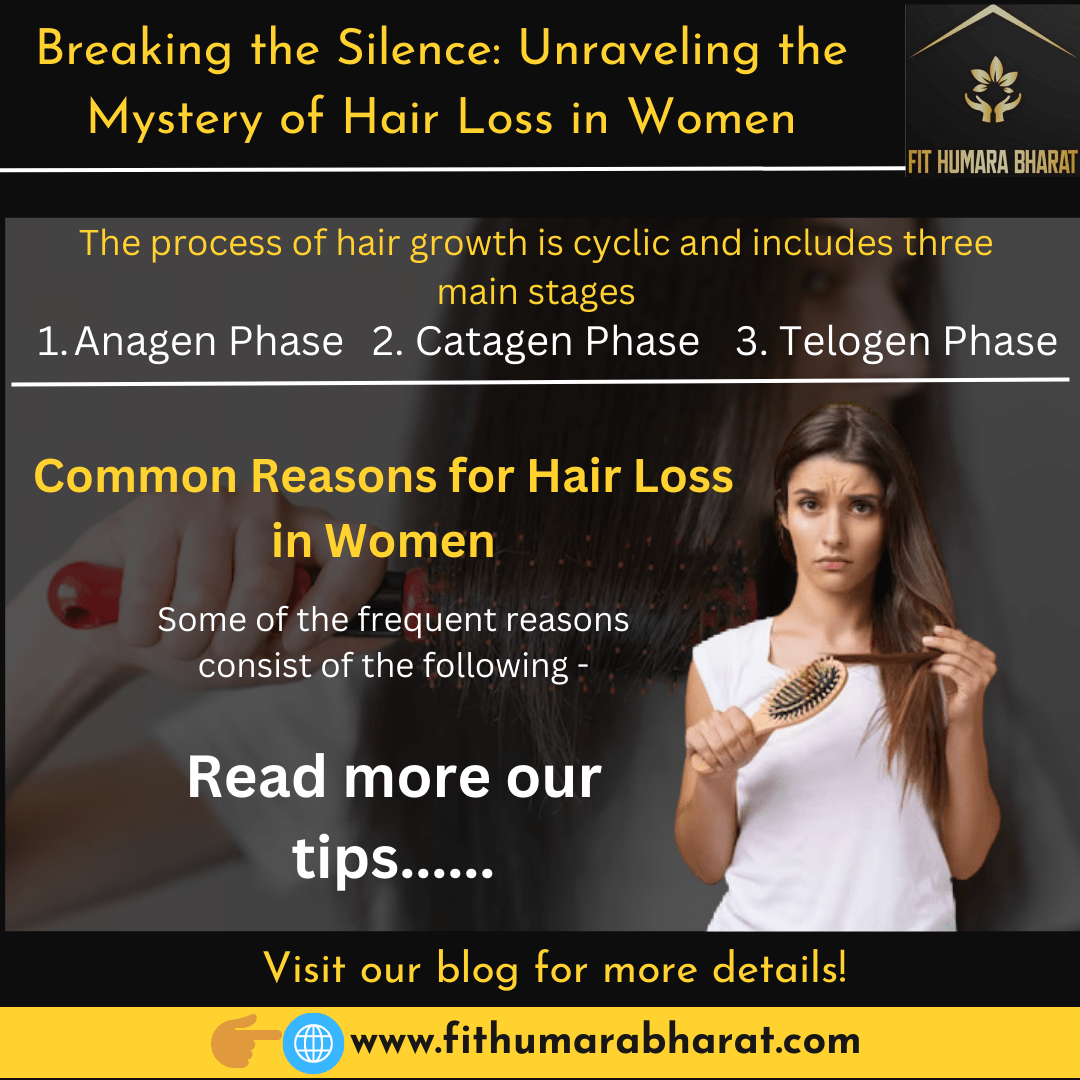Hair fall can influence your self-assurance. Though most men don’t have trouble seeking assistance for hair loss, females tend to hide it, frequently causing feelings of depression and isolation.
“Hair loss is not just related to men. According to studies, over 50% of females go through visible hair loss. The most considerable reasons behind this are FPHL or female-pattern hair loss, which influences about 1/3rd of vulnerable women.”
Although it is considered a primarily male issue, hair falls in females can be equally challenging and distressing.
In this detailed post, we will discuss the reasons for hair fall in women, discover different solutions, and highlight the significance of empowerment in handling this sensitive issue.

Table of Contents
Understanding Normal Hair Growth
Before discussing the reasons behind hair fall in women, you should comprehend the natural hair development cycle. The process of hair growth is cyclic and includes three main stages –
Anagen Phase
Anagen is the active development stage when hair fall divides quickly, causing new hair growth. The duration of this stage differs from woman to woman and can remain for many years.
Catagen Phase
In this stage, hair development slows down, and hair follicles are ready to fall into the hair strands. That stage remains for some weeks.
Telogen Phase
It’s the resting stage where the hair follicle becomes inactive, and the old hair strands ultimately fall out. New hair starts to grow when the cycle resumes.
Common Reasons for Hair Loss in Women
Hair fall in women can cause by a mixture of different factors. Some of the frequent reasons consist of the following –
1. Hormonal Imbalances
Hormonal fluxes, like those experienced during menopause, childbirth, pregnancy, or conditions like PCOS or polycystic ovary syndrome, can cause hair fall. Androgenetic alopecia is a genetic condition related to hormones and can influence women.
2. Medical Conditions
Certain medical situations, like autoimmune diseases like scalp infections, alopecia areata, and thyroid disorders, can activate hair fall in women.
3. Stress and Emotional Factors
Experiencing substantial emotional or physical stress, life transitions, or handling trauma can add to hair fall.
4. Nutritional Deficiencies
The absence of vital nutrients, especially vitamin D, biotin, zinc, and iron, can impact hair well-being and cause hair loss.
5. Hairstyles and Hair Treatments
Tight hairstyles, extreme use of heating irons or other hair-styling tools on the hair (like ponytails or braids), and chemical treatments can lead to breakage and damage.
6. Medications
Certain medicines, like those used in chemotherapy (cancer treatment) and some antidepressants, can also cause hair fall as a side effect.
7. Age and Genetics
Hair weakening is a natural aspect of the aging procedure, and heredity can also play a considerable role in deciding a woman’s vulnerability to hair loss.
Solutions and Treatments for Hair Loss
Hopefully, there are various treatments and solutions accessible to solve hair fall in women. But, it’s important to reminisce that no treatments are suitable for everyone, plus it’s good to discuss with a dermatologist or healthcare professional to come up with the most appropriate approach.
Some standard solutions consist of the following:
Modern Science for Hair Loss
1. Topical Minoxidil
2% Minoxidil is an OTC or over-the-counter medicine available for topical use in foam and liquid forms. It is supposed to be used on the scalp two times a day. 5% Minoxidil is accessible to men and can be used only once a day.
According to studies, Minoxidil is helpful for many people, and they tend to experience hair regrowth within 4-8 months.
Regrowth continues throughout the year, after which time it alleviates. Minoxidil should often be used longstanding to stop hair fall and encourage growth. After stopping the treatment, hair fall will start again in 12-24 weeks.
2. Prescription Medications
For women who experience hormonal hair loss, prescription pills like oral contraceptives or spironolactone with anti-androgenic properties may be advised.
3. Low-Level Laser Therapy (LLLT)
LLLT devices or Low-Level Laser Therapy release red lights to arouse hair follicles and encourage hair growth. Also, they are accessible in the form of helmets, caps, or combs.
4. Platelet-Rich Plasma (PRP) Therapy
Injections of PRP or protein-rich plasma are beneficial to support hair development. PRP is usually crafted from blood taken from a patient. The blood platelets are eliminated, concentrated, and placed back into the blood for injection.
5. Hair Transplantation
Hair transplant surgery involves a process where parts of scalp tissues and hair connected are extracted from one part of your scalp and shifted to spaces of baldness.
With new methods, several women profit from hair transplantation operations. However, challenges, including shock or infection, can lead to hair loss from the transplanted areas. Usually, insurance doesn’t cover the process of hair transplant.
6. Hair Care and Styling Practices
Following gentle hair care routines, reducing the use of hair styling tools, and avoiding tight hairstyles can aid in stopping further hair damage.
Home Remedies for Hair Loss
1. Healthy Diet
Start from within by nourishing your body with a well-balanced diet rich in vitamins, minerals, and proteins. Include leafy greens, nuts, eggs, and fish to promote hair health.
2. Aloe Vera Gel
Applying fresh aloe vera gel to your scalp can soothe inflammation and promote hair growth.
3. Onion Juice
The sulphur content in onion juice may stimulate hair follicles and encourage regrowth.
4. Coconut Oil
Massaging your scalp with warm coconut oil can improve blood circulation and moisturize the hair.
Natural Treatments for Hair Loss
1. Herbal Oils
Peppermint, lavender, and rosemary are some excellent herbal oil that can be combines with carrier oil plus you can massage with this oil on your scalp to improve your hair growth.
2. Essential Oils
Clary sage, thyme, and cedarwood are some essential oils that you can add to your hair care regimen for their prospective hair-strengthening properties.
3. Green Tea
It contains antioxidants that are helpful to prevent the bustle of certain enzymes that add to hair loss.
4. Dietary Changes
A nutritious and balanced diet comprising minerals, vitamins, and protein vital for hair well-being can promote hair development.
Ayurveda and Naturopathy for Hair Loss
1. Amla (Indian Gooseberry)
Rich in vitamin C, amla can be consumed or applied topically to promote hair growth.
2. Bhringraj Oil
Derived from the bhringraj herb, this oil is believed to nourish hair follicles and strengthen hair.
3. Nutritional Detox
Undergoing a naturopathic detox can help eliminate toxins contributing to hair loss and promote overall well-being.
Acupressure Points for Hair Loss
This process involves applying mild pressure to specific points on your body to arouse energy flow. There are some useful acupressure points that are helpful to solve the issue of hair loss.
1. Baihui (GV20)
Located on the top of the head, this point is believed to improve blood circulation to the scalp.
2. Fengchi (GB20)
Found at the base of the skull, stimulating this point may help relieve stress and promote hair health.
3. Yintang (GV24.5)
Positioned between the eyebrows, Yintang reduces tension and improves overall circulation
Empowerment and Self-Acceptance
While looking for treatment or solutions for fair fall is crucial, it’s equally important for women to embrace empowerment and self-acceptance. Hair fall doesn’t describe a woman’s beauty or worth. Comprehending that hair fall is a frequent problem that several women experience can aid in decreasing the emotional impact.
Following are some helpful empowering tips for females to handle hair loss –
1. Take Support
Connect with online communities or Support groups where females share their experiences and give Support.
2. Experiment with Hairstyles
Try various hairstyles that match your existing hair conditions, and keep in mind that accessories like headbands and scarves can also be fashionable solutions.
3. Prioritize Self-Care
Involve in activities that reduce stress and promote relaxation, such as meditation or yoga with your favorite people.
4. Consult with Professionals
Look for assistance from hair stylists who work with customers facing their loss. They can provide precious tips on styles and haircuts that create the delusion of volume.
5. Embrace Hair Accessories
Experiment with hairpieces, hats, and headscarves that cater as stylish accessories and safeguard your hair and scalp.
Conclusion
Hair loss in females is a sensitive and complex problem with a deep emotional impact. Comprehending the reasons for hair fall and the accessible treatment options can assist and hope to women seeking solutions.
Furthermore, prioritizing overall well-being, seeking Support, and embracing self-acceptance are empowering measures that can assist women to steer their hair fall process with grace and confidence.
Remember, the problem of hair fall is common among women, plus there are options and resources accessible to aid you in regaining your self-assurance and recovering your sense of self.
Thank You
- Female pattern hair loss: A clinical, pathophysiologic, and therapeutic review
- Female pattern hair loss: Current treatment concepts
- The Female Pattern Hair Loss: Review of Etiopathogenesis and Diagnosis
- Practical Approach to Hair Loss Diagnosis
- Female Pattern Hair Loss—An Update




 Sources
Sources